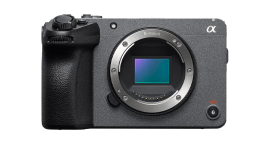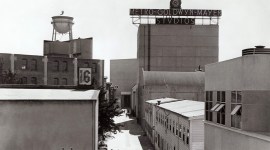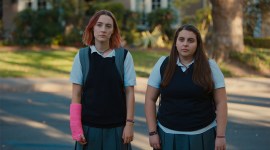
The Cameras and Lenses Behind Oscar-Nominated Films
Let’s turn the spotlight on 2021’s Oscar nominees and see what cameras and lenses their crews used to create the biggest films of the year.
Here’s a look at the cameras and lenses used on Best Picture and Best Cinematography nominees. Yes, plenty of ARRI ALEXA, but a few surprise cameras, too.
Judas and the Black Messiah
6 Nominations: Best Picture, Best Cinematography (Sean Bobbitt), Best Actor (Daniel Kaluuya), Best Supporting Actor (LaKeith Stanfield), Best Original Song, Best Screenplay.

Shot by Sean Bobbitt on the ARRI ALEXA LF and ARRI ALEXA Mini LF using DNA LF lenses. As for filming a diverse cast, Bobbitt shares about the cameras’ abilities:
The contrast ratio is brilliant. It could hold the full gamut of all of the flesh tones that we were dealing with. And, it was very important to us that we get accurate flesh tones and that no one was washed out.
-Cinematographer Sean Bobbitt via Variety
Mank
10 Nominations: Best Picture, Best Director (David Fincher), Best Cinematography (Erik Messerschmidt), Best Actor (Gary Oldman), Best Actress (Amanda Seyfried), Best Sound, Best Original Score, Best Production Design, Best Costumes, Best Makeup and Hairstyling.

David Fincher’s approach to filmmaking and intense level of detail certainly meant that the film was going to be shot digitally and not on film, even if it was appropriate for a period piece. The film was shot by Erik Messerschmidt on the RED Ranger Helium Monochrome with Leica lenses, about which he says:
We knew we wanted to do most of the film in deep focus, which is a little bit of an homage to Gregg Toland, so we required a 35mm-sized sensor. But, I did extensive testing—weeks and weeks of it. I went to Panavision two or three times, looked at every lens they had. I met with [VP of Optical Engineering] Dan Sasaki there, and I did the same at Keslow Camera. I looked at every single spherical lens they had, looking for the lenses that would give us the best results at deep focus. And believe it or not, we did end back on the Leicas, which we’d shot on Mindhunter. That was not my expectation at all, and it wasn’t David’s, either. It’s just the way the math worked out.
-Cinematographer Erik Messerschmidt via Deadline
For an absolutely stellar gallery and some of the most gorgeous behind-the-scenes photos I’ve ever seen, check out the Mank set photos from Miles Crist and Nikolai Loveikis at thewhitewinecameupwiththefish.com.
Nomadland
6 Nominations: Best Picture, Best Director (Chloe Zhao), Best Cinematography (Joshua James Richards), Best Actress (Frances McDormand), Best Adapted Screenplay (Chloe Zhao), Best Editor (Chloe Zhao).

Chloe Zhao and Joshu James Richards turned to ARRI Rentals for Nomadland, shooting on both the ARRI ALEXA Mini and the ARRI Amira. The cameras were often paired with 16mm, 18mm, and 32mm ultra primes.
Richards revealed:
I knew we needed to be as nimble as ever, but also it needed to feel like a voyage through this place . . . We chose the Ronin 2 gimbal because it was small, and we had one ALEXA Mini on the gimbal the whole time, and another one just ready to run-and-gun and shoot. It just made us really flexible to any situation.
-Cinematographer Joshua James Richards via ARRI Rental
I had such a fear of cameras and technology starting out. When I first arrived at NYU, I didn’t know what an F-stop was. I want to tell young cinematographers starting out, who don’t have that confidence, kinda don’t worry because along the way, you will find people who will support you.
The Trial of the Chicago 7
6 Nominations: Best Picture, Best Cinematography (Phedon Papamichael), Best Screenplay, Best Editing (Alan Baumgarten), Best Actor (Sacha Baron Cohen), Best Original Song.

The film was shot by Phedon Papamichael on the ARRI ALEXA LF and ARRI ALEXA Mini LF using Panavision C-Series, T-Series, B-Series, and Canon K35 lenses.
I went with the same package—a large frame with expanded anamorphics we custom-built and discovered with Ford v Ferrari. That was the first time it was done with Panavision C-series and B-series lenses.
-Cinematographer Phedon Papamichael via British Cinematographer
Minari
6 Nominations: Best Picture, Best Director (Lee Isaac Chung), Best Actor (Steven Yeun), Best Actress (Youn Yuh-jung), Best Screenplay, Best Original Score.

Shot on the ARRI ALEXA Mini with Panavision P vintage lenses by Lachlan Milne. Milne talks about the candid moments that were captured organically, where the cinematographer would pull inspiration from Terrence Malick.
There were definitely a couple of moments that were spontaneous. There’s a scene in the film just after sunset when Jacob is smoking a cigarette by himself in the field. It was a transition between day and night and I had just taken the camera out to shoot the sunset as a transitional shot. We didn’t have a lot of time to establish day to night themes, but we wanted to get a shot to give the film a bit of pacing. Steven just happened to walk up behind me and he was just taking five and smoking a cigarette, and I saw him there and just took the camera and kept rolling. I walked out toward him and shot 3-4 shots without cutting and that ended up in the film. I had quite a wide lens on him because I was getting these sunset shots, and I think it unintentionally ended up feeling like a Malick-y sort of sequence. For me, visually, there’s definitely some Terrence Malick in this film, for sure.
-Cinematographer Lachlan Milne via Awards Daily
Sound of Metal
6 Nominations: Best Picture, Best Editing (Mikkel E.G. Nielsen), Best Actor (Riz Ahmed), Best Supporting Actor (Paul Raci), Best Sound, Best Screenplay.

Sound of Metal was one of the few nominated pictures that was shot on film. Cinematographer Daniël Bouquet captured the Best Picture nominee on the Aaton Penelope camera with Sigma 35 lenses. For filmstock, they went with Kodak Vision3 50D 5203, Vision3 250D 5207, and Vision3 500T 5219.
But, why did director Darius Marder chose to shoot on film?
Because it’s my goddamn movie, that’s why.
Because I fought for this movie and no one was going to tell me no. I basically hijacked the whole goddamn set, and that’s the deal because no one lets you do anything in this business and it’s made up of absolutely cowardly people. And, if you don’t know what you want and aren’t willing to fight with it, you’re not going to get it. That’s all there is to it.
Now shooting on film, I love it. People have very, very compartmentalized ways of thinking. Like, “Film is more expensive in the end,” you know? Well, it’s not true at all. Shooting digital is expensive. When you’re shooting digital, you can just shoot and shoot and shoot and shoot. What does that mean? Overtime. There’s nothing more expensive on a film set than overtime. When you shoot on film, you have to know the law, you have to know what you’re going for and you have to be willing to swing for it and not think you can just shoot forever, and that’s the ethical gift unto itself. I think if you’re looking to find your film on the site, don’t shoot on film.
-Director Darius Marder via Slash Film
The Father
6 Nominations: Best Picture, Best Editing (Yorgos Lamprinos), Best Actor (Anthony Hopkins), Best Actress (Olivia Colman), Best Adapted Screenplay, Best Production Design.

The Father was shot by Ben Smithard on the Sony VENICE with Zeiss Supreme lenses. Director/Writer Florian Zeller talks about filming Anthony Hopkins’ emotional performance:
It was the real challenge for him just to let everything go. It was not easy to shoot that scene and when it appeared, all the emotions that we can see in the film, I can tell you everyone on set was crying, because it was something very powerful and truthful and sincere, meaning that he was really talking about himself, in a way. It was a strange experience because it was, at the same time, one of the most joyful moments of my life and one of the saddest experiences that we had, because what he was expressing was so sad and so universal, in a way.
-Director Florian Zeller via Deadline
Promising Young Woman
5 Nominations: Best Picture, Best Director (Emerald Fennell), Best Editing (Frédéric Thoraval), Best Actress (Carey Mulligan), Best Screenplay.

Promising Young Woman was captured by Benjamin Kracun on the ARRI ALEXA Mini with Panavision G-series lenses. The film draws from many pop-heavy cultural films from the 1990s, such as Clueless or To Die For, which Kracun reveals:
With my DIT Chase Abrams, I built a LUT that was influenced by those soft, ’90s aesthetics to help bring out the pastels. What was in front of the camera was strong and pronounced and quite clear the colors we were going for. They were all there in Cassie’s manicure—a rainbow of turquoise, teal, yellow, light pink, and fuchsia.
-Cinematographer Benjamin Kracun via British Cinematographer
News of the World
4 Nominations: Best Cinematography (Dariusz Wolski), Best Production Design, Best Sound, Best Original Score.

The Paul Greengrass western starring Tom Hanks was filmed by Dariusz Wolski on the ARRI ALEXA LF and ARRI ALEXA Mini LF, with Panavision Vintage 65 primes and Angénieux Optimo EZ1 and EZ2 zoom lenses. As for capturing the drama, Wolski says:
There was a desire to be close and, other times, you have to back off. Another way of portraying drama is just by putting two people in the middle of this huge landscape.
-Cinematographer Dariusz Woldski via Variety
- 8K Showdown: The Sony Alpha 1 vs. the Canon EOS R5
- Hands-on Review: the Blackmagic Pocket Cinema Camera 6K Pro
- Vintage Cinema Lenses: Canon K35s vs. Canon FDs
- The Ultimate VFX Camera: Blackmagic URSA Mini Pro 12K Review
- Cameras Behind Golden Globe Winners and Nominees
Cover image via Miles Crist/NETFLIX






